Heavy Industries
Overview
Kawasaki Heavy Industries : Industrial Robot
Kawasaki Heavy Industries is the first in Japan to develop and manufacture domestic industrial robots, and since then has been a leading manufacturer of robots that supports automation in various manufacturing fields. Kawasaki robots realize high-quality automation work that matches the requirements of individual products and production lines, such as welding of automobile bodies and processing of food.
Project Background & Goals
In each team in the Robot Business Center, one PM is always in charge of multiple design and development projects, so it was difficult to plan the project, manage personnel resources and outsource. In order to reduce management man-hours and improve the management level, it has become an urgent issue to enable related parties to share project information without delay and manage progress from remote locations.
Project Approach
Using Aras Innovator, which has become the standard PLM within Kawasaki Heavy Industries, as a platform, we decided to build it using DTM, which is a package that extends the PM function of Aras. From the beginning, the team representative participated in the evaluation, and with the support of the user representative lead and the IT staff of the robot business center, we expanded the functions and realized the requirements required for our company.
Benefits
Based on inquiries from customers, PMs and development leaders register project information and its plans in DTM, confirm the personnel load, assign the main person in charge, and create a plan. When the plan output from the DTM is finalized in consultation with the customer, the worker is notified of the work assigned on a daily basis and the PM can grasp the progress in a timely manner by registering the actual results. increase. With this mechanism, it became possible to smoothly manage ongoing projects without frequent email exchanges, and the effects of reducing PM management man-hours and improving the milestone compliance rate were shown.
LS Industrial Systems
Business Environment
LS Industrial Systems belongs to the LS Group (a group of 17 companies such as LS Cable & System and LS Nikko Copper Tube), which was spun off from the LG Group, which is internationally famous as a Korean chaebol company, and is used for industrial power equipment and automation equipment. As a company responsible for the field, we have the largest share in Korea. We also handle low-voltage equipment such as circuit breakers and magnetic contactors, high-voltage equipment such as VCBs and mold transformers, and special high-voltage power systems such as switchgear, RMU, and GIS. In automation equipment, we have entered the rapidly growing industry of photovoltaic power generation, including inverters, PLCs, and HMIs, and have also entered fields such as EVs and RFID.
Project Background & Goals
In individual build-to-order business such as plant equipment, the process from estimation of inquiries about projects to design, production, and installation is carried out as project-type work, and process planning is carried out while procuring equipment and resources not only from internal but also from external partner companies. It is essential to thoroughly inform and proceed without delay. In addition, cost control and profitability for the order amount is a mission that should be protected in any case.
Under these strict conditions, using Dynamic Task Manager, we have built a function for (1) integrated management of schedules and costs, (2) project cost management by linking the ERP system, and (3) progress monitoring function for the entire project.
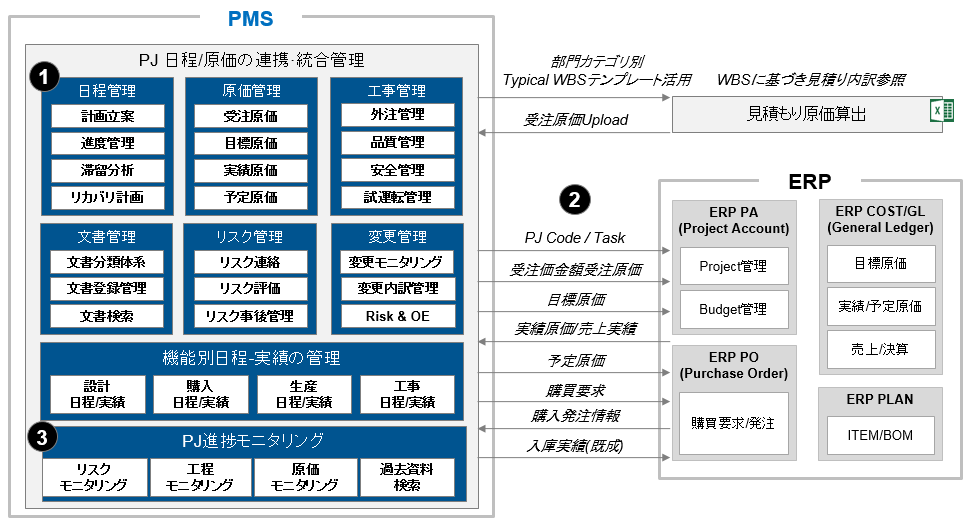
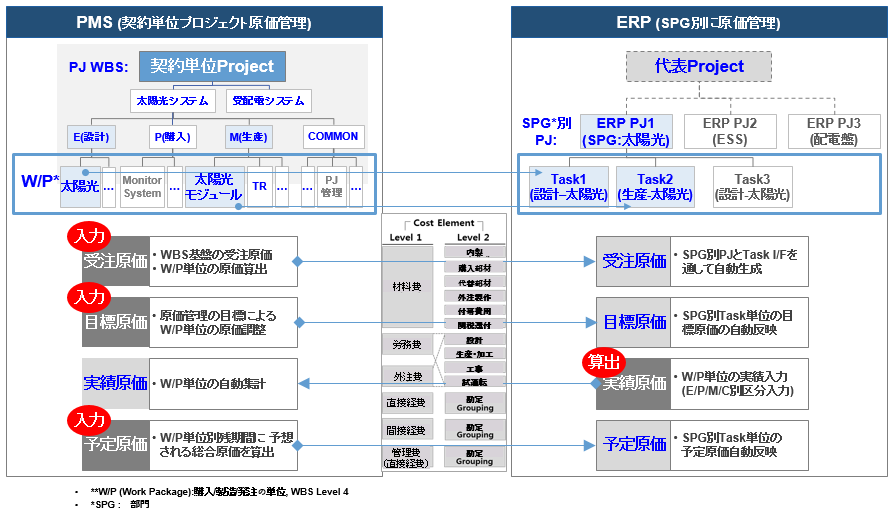
Define the management level of WBS (activity aggregation unit), clearly position the 4th level as "Work Package", manage procurement, manufacturing and cost in that unit, "order cost" "target cost" " Set "planned cost" and link it with Task managed by ERP. Therefore, in ERP, it is possible to aggregate the actual results entered for each SPG (department) and adjust the "planned cost" by matching it with the target cost.
In order to monitor the progress of the entire project from the planning to the end of the project, it is possible to check the ordering process / Gate / phase information of each project by SPG (department), and the project manager is informed of the schedule of the entire project. We have created a system that can monitor progress and cost risks.
Benefits
By sharing and visualizing the work process in progress and using a common platform, the work that was done individually can be connected on one database, and not only the project manager but also the individual engineers can confirm each other's work. At the same time, we have made it possible to carry out process management across departments and departments, where each person can work with a management consciousness by paying attention to the overall management.
In addition, by providing an EVM chart, it is possible to support decision-making so that the risk of cost overrun can be recognized and dealt with at an early stage, and it can be used not only for project planning and progress management, but also for budget and cost management departments. Was built. Despite such a full-scale system construction, we succeeded in achieving an overall release within a period of about 10 months from the start of the system.
Doosan Heavy Industries
Business Environment
Doosan Heavy Industries is a comprehensive heavy industry company belonging to the Doosan corporate group in South Korea, which produces power generation equipment, plant equipment, infrastructure equipment, etc., and is responsible for the construction of large plants and power plants overseas such as Saudi Arabia and India. A global EPC company.
Project Background & Goals
Doosan Heavy Industries' power plant facilities and turbine design and development work are done by individual order design, and there are problems that hinder business expansion, such as decentralization of various engineering data, personalization of design process, and invisible design schedule. I was holding it. In order to maintain cost competitiveness, it is essential to improve operational efficiency and ensure quality, but the process is complicated in order to expand projects and comply with strict laws and regulations, and we have to rely on individual skills and ingenuity. Under these circumstances, it was difficult to adapt the PLM system that supports the conventional parts assembly method. Therefore, in anticipation of future changes, we decided to build a system using the SI development method based on the Aras platform, which guarantees scalability and flexibility.
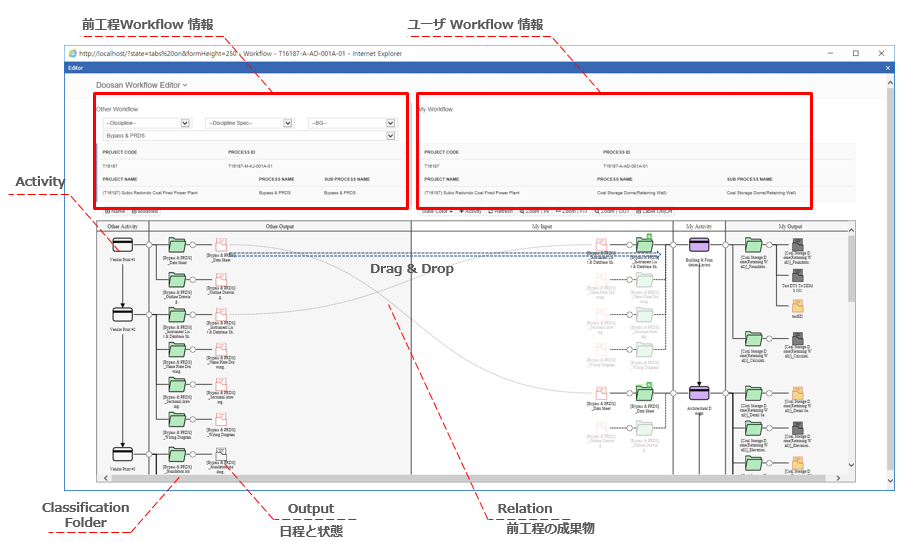
First, we aimed to "standardize the design process" to carry out the design procedure accurately, and for that purpose, we defined a standard process according to the project type and managed it in the database as a standard workflow template. Workflow tasks are defined in conjunction with project scheduling using the Aras Innovator add-on Dynamic Task Manager, and Gantt charts are used for scheduling sharing.
Next, in order to systematically manage the specification information of equipment and equipment, the engineering database is utilized, the standard classification of equipment and equipment is defined (equipment template), and the specification information and modeling information are given to each. , Becomes a library of equipment and imports this information to create 3D modeling. The attribute values required for management are assigned to each device, and access rights are also set for each list or item.
Benefits
By defining workflows and standardizing business processes, the essence of an integrated design environment was built. In order to thoroughly execute the design process according to the workflow, we have developed and provided an editor that associates activities and deliverables with an easy-to-use workflow definition drawing function and graphical management screen so that all users can use it without any resistance. Did. As a result, the business procedure is visualized, and it is possible to intuitively grasp the relationship between the business status and the document.
Since specification information can be systematically managed by utilizing the equipment library and engineering DB, the quantity of materials and equipment required is calculated by 3D modeling, which is the source data for equipment procurement, construction, and production, as well as for similar projects. It was also possible to reuse it for estimation.
The engineering portal allows stakeholders to share updates in a timely manner and improve design integrity. All parties can use this portal page for delivery / request procedures and data registration, information related to them is constantly updated as a new feed, and the status of the project can be checked on the dashboard.
Currently, we are further collaborating with SCM to support a wide range of portfolios.
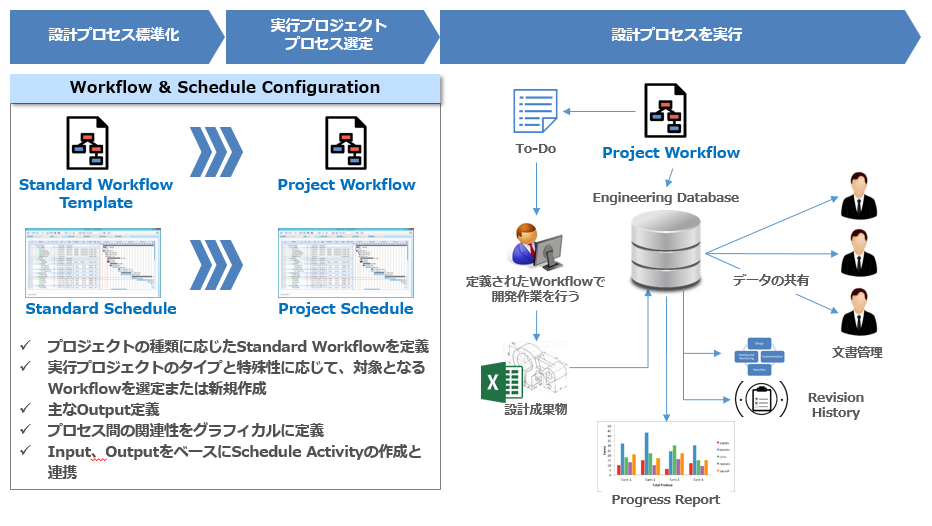
Hanwha Techwin
Business Environment
Since starting the aircraft engine and camera business in 1977, Hanwha Techwin has played an important role in the development of the precision machinery industry, expanding its business domain to semiconductor manufacturing equipment parts, turbo compressors, self-propelled artillery, etc. Did. We also produce high-tech products such as video information equipment that requires cutting-edge technology in the multimedia age. Hanwha Techwin is about to make a leap forward as a global leader in Safety & Energy case 04 with the best technology in the precision machinery field. In particular, the Power Systems Division is in charge of the aircraft engine, engine parts, and energy equipment businesses.
Project Background & Goals
Hanwha Techwin's Power Systems Division, which has introduced the SCM solution provided by Zionex, supports the ETO (Engineer To Order) production method. The ETO method-that is, “custom design production strategy” means a method of producing with the individual design requested by each customer while placing an order. In the ETO strategy, it is also called ”Project method” because it has the characteristics of production by ordering large-scale project characteristics. At that time, Hanwha Techwin had a longer lead time for customer delivery due to unnecessary yard waiting time, and plans were not systematically synchronized between factories. We also had problems such as not being able to respond promptly to orders and changes in specifications. In order to solve these problems and improve inventory reduction and customer on-time delivery rate, Hanwha Techwin has selected and started a project to implement Zionex's SCM solution. What we sought to achieve through the project was the establishment of a weekly and monthly production execution planning system that takes into account equipment capacity and material availability.
Benefits
After introducing the SCM solution, Hanwha Techwin decided to implement the following four. First, automation of production planning and management tasks. Second, establish an advanced management system by forecasting equipment load status and inventory levels on a monthly and weekly basis. Thirdly, by establishing a system that can re-formulate the plan within one hour according to the change of the plan and synchronizing the information between the delivery date / production plan / material requirements schedule, it is possible to respond immediately to the change. Equipped with a system. Fourth, we operated a tool for monitoring continuous planned performance comparisons. Through this SCM solution implementation project, Hanwha Techwin was able to reduce parts inventory days and improve production planning compliance. We have also succeeded in improving the implementation rate of daily work plans by more than 90%, reducing process waiting time and reducing lead time.
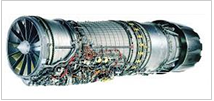
Korea KOSO
Business Environment
Established in 1979, Korea KOSO Co., Ltd. is a wholly owned company of Nippon Koso Co., Ltd. Nippon Koso Co., Ltd. was established in 1965 and is a world leader in the field of industrial automated control valves. Korea KOSO assembles special valves and various parts that require advanced technology and provides them to domestic global companies in the shipbuilding and plant industries.
Project Background & Goals
Korea KOSO faced three major business challenges at the time, and first of all, it was necessary to systematize large-scale contract management with EPC (Engineering, Procurement & Construction) customers. Second, we needed to reasonably manage our customers' new designs and their manufacturing requirements, and ultimately we needed to implement a system that would allow us to collaborate with customers and suppliers around the world. In addition, the valves produced in Korea KOSO are DTO (Design To Order) or ETO (Engineer To Order) production forms. In this case, organic cooperation and data integration between processes including product development, purchasing, and production are carried out. Is an important factor in competitiveness. As a solution to this situation, Korea KOSO has built a PLSCM system by promoting process innovation linked with the integration of PLM and SCM based on Aras Innovator, a PLM (Product Lifecycle Management) solution.
Benefits
In the PLM area, we have established a product information management system and incorporated a value chain-based project management process into the PLSCM system. In addition, we have strengthened our QCD (quality, cost, delivery) capabilities and are now able to manage company-wide bill of materials (BOM). Korea KOSO also promoted supply chain innovation aimed at meeting deadlines and reducing inventory, along with a rapid decision-making process to ensure supply chain visibility. As a result, we have strengthened the foundation for collaboration with outsourced supply chain companies. Finally, through the PLSCM system, we were able to comprehensively improve the processes and value chain within the company, from ordering – development – procurement – production. In the sales management function, customer information management function, quotation management and profit margin automatic calculation function, specification management function, design, production progress confirmation function, etc. have been implemented. Engineering management functions include technical specification management functions, parts, and BOM management functions, and CAD Integration functions. In the production control area, design progress management functions for each valve, valve-specific operation (Operation) management and work progress management functions are implemented, and in the purchase and quality areas, department-specific operations (Operation) are implemented. Management, operation progress management, quality department report management, etc. have been realized.

